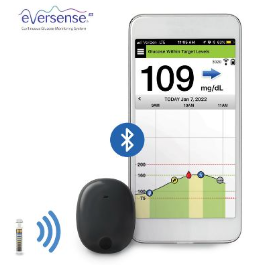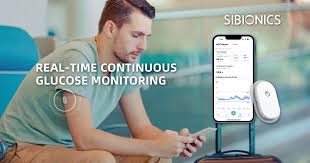Senseonics completes 365-day CGM study cohort by Sean Whooley for DrugDeliveryBusiness.com, 26 September 2023.
 Senseonics announced that it completed its ENHANCE pivotal clinical study adult cohort for its 365-day Eversense CGM. The study evaluates the year-long implantable continuous glucose monitor in adults. It also has a pediatric cohort (ages 14 to 18), which saw its first patient insertion in April. More than 165 adult subjects received Eversense insertions across four U.S. centers. Senseonics also used data from the study to support its FDA submission for integrated continuous glucose monitoring (iCGM) designation this year.
Senseonics announced that it completed its ENHANCE pivotal clinical study adult cohort for its 365-day Eversense CGM. The study evaluates the year-long implantable continuous glucose monitor in adults. It also has a pediatric cohort (ages 14 to 18), which saw its first patient insertion in April. More than 165 adult subjects received Eversense insertions across four U.S. centers. Senseonics also used data from the study to support its FDA submission for integrated continuous glucose monitoring (iCGM) designation this year.
Senseonics Chief Medical Officer Dr. Francine Kaufman says the company aims to secure approval for the 365-day CGM “in the coming quarters. “We are pleased that all patients have completed the testing for the adult arm of the ENHANCE clinical study,” Kaufman said in a news release. “Demonstration of safe and accurate performance of Eversense for 365 days in this study would further validate its ability to facilitate more effective and longer-term management of diabetes. This represents a major milestone for Senseonics as we work towards offering the differentiated benefits of implantable CGM for one full year with just a single sensor.”
Read more: Senseonics completes 365-day CGM study cohort
SiBionics CGM enters the fray by Tim Street for Diabettech.com, 26 September 2023.
Do you feel LUCKY? SiBionics is offering a FREE GIVEAWAY EVENT, which ends on 10 October.
 : 1 SIBIONICS GS1 for free
: 1 SIBIONICS GS1 for free
 : 2 lucky winners will be selected
: 2 lucky winners will be selected
 : We will end the giveaway on October 10th and announce the winner
: We will end the giveaway on October 10th and announce the winner
Here’s the link, as shared on Facebook: Sibionics Free GIVEAWAY! All it takes is a few simple steps to enter:
-
-
- Share 3 photos showcasing your life with diabetes. It could be:
- a snapshot of your glucose level with SIBIONICS GS1,
- a delectable treat you whipped up to keep those levels in check, or even
- a glimpse of your workout routine for better glucose management.
- Don’t forget to @sibionicscgm and @ one of your friends in your post and let them to jump on board!
- Add #ShareLifeWithSIBIONICS in post
- Share 3 photos showcasing your life with diabetes. It could be:
-
GOOD LUCK! Wish they were giving away more … I’d love to try one!
 According to Tim Street: Similar to the Libre, the system comes in two parts that are clicked together and then stuck on the arm to insert it. The insertion process is identical to their CKM. Similar to the Libre, you push it down against your arm, but in this case, it has a button on top that you press to release the mechanism, rather than automatically releasing it. It also comes with an overlay patch that contains a plastic ring to make it easier to locate, and that is presumably to stabilize the basic patch.
According to Tim Street: Similar to the Libre, the system comes in two parts that are clicked together and then stuck on the arm to insert it. The insertion process is identical to their CKM. Similar to the Libre, you push it down against your arm, but in this case, it has a button on top that you press to release the mechanism, rather than automatically releasing it. It also comes with an overlay patch that contains a plastic ring to make it easier to locate, and that is presumably to stabilize the basic patch.
The app is one of the better ones that we’ve had from one of the newcomers in the CGM world. The standard view this one provides shows glucose data for the last three hours, with six, twelve, and 24-hour options available. There are also daily reports showing Time in, above, and below range, the daily trend, AGP reports which also include an overlay function that gives a day-by-day comparison plus data input functions, and on the Profile page, there’s a way to export blood readings. The video below walks through the app.
Read more: SiBionics CGM enters the fray
Abvance’s Novel Coformulation of Insulin and Glucagon Could Revolutionize Diabetes Care by StartUpHealth for HealthTransformer.co, 20 September 2023.
 A team of scientists and physicians have discovered that insulin and glucagon, long thought solely to counteract one another as they lower or raise blood sugar levels, respectively, could actually work together for better and safer glycemic control. If Abvance’s foundational work proves out, people with diabetes who require insulin could have an easy and safe way to control their blood glucose levels more effectively without running the risk of hypoglycemia.
A team of scientists and physicians have discovered that insulin and glucagon, long thought solely to counteract one another as they lower or raise blood sugar levels, respectively, could actually work together for better and safer glycemic control. If Abvance’s foundational work proves out, people with diabetes who require insulin could have an easy and safe way to control their blood glucose levels more effectively without running the risk of hypoglycemia.
Medically speaking, two main peptides help people with T1D maintain their glycemic tightrope walk. Insulin brings blood sugar down when it is too high, and glucagon brings blood sugar back up when it drops too low. Because of their opposite functions, physicians and researchers have always considered them as adversaries, like two boxers duking it out in the ring. That’s certainly what David Maggs, MD/endocrinologist from Kent, UK, thought, until one fateful evening in Boston when he was walking to a restaurant with Alan Cherrington, PhD, a world leader in understanding the roles of insulin and glucagon in the body.
Cherrington explained his recent animal studies to Maggs in which he put insulin and glucagon together, delivering the two peptides at the same time and at very specific molar ratios. Instead of the cage match the researchers anticipated, the two peptides actually responded dynamically to what the body needed: it wasn’t a fight, it was a dance, with each of the two peptides moving fluidly and intuitively to address rising and falling blood sugar levels.
Several years later, as they sat with the clinical staff, Bruce Bode, MD, a well-respected researcher in the insulin field and a founding partner at Atlanta Diabetes where the clinical trial was being conducted, walked into the room, stunned. “The damn thing works,” Bode said.
While the previous assumption was that delivering insulin and glucagon at the same time would be like simultaneously slamming on the brakes and accelerator in an automobile, it turned out that the two peptides, when delivered at a precise molar ratio, worked together to regulate blood glucose. When glucose rose, insulin dominated the actions of glucagon, and when glucose fell, glucagon dominated insulin in the opposing direction. The gas and the brakes responded as necessary, together making it a much smoother and predictable ride.
 Together with Cherrington and peptide chemist Soumitra Ghosh, PhD, Maggs founded Abvance Therapeutics to develop a coformulation of short acting insulin and glucagon as a kind of “smart insulin” that responds in real time to blood sugar levels. The founders approached another biotech company in 2019 for potential assistance in the coformulation work, and while that company passed on the opportunity, the then US General Manager, Steve Daly, found the Abvance data incredibly compelling, so compelling that he eventually came on board as COO in 2023.
Together with Cherrington and peptide chemist Soumitra Ghosh, PhD, Maggs founded Abvance Therapeutics to develop a coformulation of short acting insulin and glucagon as a kind of “smart insulin” that responds in real time to blood sugar levels. The founders approached another biotech company in 2019 for potential assistance in the coformulation work, and while that company passed on the opportunity, the then US General Manager, Steve Daly, found the Abvance data incredibly compelling, so compelling that he eventually came on board as COO in 2023.
Abvance is on the cusp of having the necessary funding to advance their solution, called ABV100, into coformulation development, large animal work, and then IND (Investigational New Drug) enablement with the FDA to move forward with testing in human subjects.
Read more: Abvance’s Novel Coformulation of Insulin and Glucagon Could Revolutionize Diabetes Care
Food cravings before a period? New study could explain the reason by Katharine Lang for MedicalNewsToday.com, 29 September 2023.
 Craving chocolate and carbohydrate-rich foods in the days before a menstrual period, resulting in weight gain, is common in many people who menstruate. New research, recently published in Nature Metabolism, has found that insulin sensitivity — the response of your cells to the hormone insulin — varies throughout the menstrual cycle, being the highest in the days before ovulation and lowest in the run-up to a menstrual period. The researchers suggest their findings explain why so many women experience hunger just prior to getting their period, why their metabolism slows, and why weight gain is so much more likely.
Craving chocolate and carbohydrate-rich foods in the days before a menstrual period, resulting in weight gain, is common in many people who menstruate. New research, recently published in Nature Metabolism, has found that insulin sensitivity — the response of your cells to the hormone insulin — varies throughout the menstrual cycle, being the highest in the days before ovulation and lowest in the run-up to a menstrual period. The researchers suggest their findings explain why so many women experience hunger just prior to getting their period, why their metabolism slows, and why weight gain is so much more likely.
“This is an interesting finding — diabetics have reported cyclical changes in their blood sugar management for many years. It is great to see some research into this at last!” said Sally King, founder of Menstrual Matters, a fellow in menstrual physiology, Dept. of Women and Children’s Health, King’s College London, who was not involved in the study.
The researchers found that in lean women, brain insulin action improved peripheral insulin sensitivity during the follicular phase but not in the luteal phase. Commenting on the findings in an accompanying Nature Metabolism article, Prof. Dr. Nils B. Kroemer suggested: “this study raises the intriguing possibility of a central role (both figuratively and literally) of insulin signaling in the brain in orchestrating metabolic adaptations during the menstrual cycle.” He suggests that the reduced insulin sensitivity in the premenstrual phase could help explain the food cravings and changes in appetite and body weight experienced by many people at this time.
Read more: Food cravings before a period? New study could explain the reason
Ozempic May Reduce Insulin Needs in People With Type 1 Diabetes by April Hopcroft for diaTribe.org, 25 September 2023.
Early research suggests that people with type 1 diabetes who started semaglutide within three months of diagnosis were able to stop taking mealtime insulin. The benefits of Ozempic (semaglutide) continue to stack up for people with type 2 diabetes and obesity, with the latest data showing that it reduces heart disease and stroke in people with obesity who don’t have diabetes.
Semaglutide is also being studied for other conditions, such as fatty liver disease and addiction. However, people with type 1 diabetes have largely been left out of the conversation as there have been fewer studies on semaglutide as a treatment for type 1.
New research suggests that semaglutide may in fact have benefits in early type 1 diabetes – specifically, the potential to reduce insulin needs. One study shows possible benefits for semaglutide in new-onset type 1 diabetes – both to manage blood sugar and reduce insulin needs. Although the study size was small and not randomized, semaglutide may reduce blood glucose levels and eliminate the need for mealtime insulin in some people with type 1 diabetes. Previous research has shown benefits of a similar GLP-1 drug, liraglutide, on glucose, weight, and insulin doses in larger samples of people with type 1 diabetes.
Another small study suggested that semaglutide may be beneficial for people with longstanding type 1 diabetes. Among 10 adults who had type 1 diabetes for an average of 20 years, semaglutide led to 14% weight loss over six months. Beyond weight loss, participants saw a 25% reduction in daily carbohydrate intake and a 26% reduction in insulin doses per day at six months.
I’ve been using Ozempic for the past 2 years, at a very minimal dose. As an N=1, I’ve reduced my daily insulin dosage by 30%, lost weight, don’t have food cravings and feel well.
Read more: Ozempic May Reduce Insulin Needs in People With Type 1 Diabetes
CVS hit with lawsuit from independent pharmacy over fees by Rebecca Pifer for HealthCareDive.com, 28 September 2023.
Maquoketa, Iowa-based Osterhaus filed the suit in a Washington district court. The complaint accuses CVS of violating federal antitrust laws and state contract statutes through its application of performance adjustment fees in Medicare Part D. The direct remuneration fees allow the PBM to retroactively adjust how much pharmacies are reimbursed based on their quality performance.
Much of the criteria used by CVS to adjust payments “make no sense,” are applied at Caremark’s “complete discretion” or are outside pharmacy control, the lawsuit says. However, opting out of Caremark contracts would “severely limit a pharmacy’s access to a critical mass of patients,” so pharmacies “generally have no practical choice but to participate.”
CVS Caremark is the largest PBM in the U.S., accounting for 33% of all prescriptions filled nationally. CVS denies the allegations. “We believe the allegations are without merit and intend to defend ourselves vigorously,” CVS Corporate Communications Director Michael DeAngelis said.
Independent pharmacies have been closing across the U.S. but especially in rural areas due to increased financial pressures — including from PBMs, which reimburse independent pharmacists at lower levels than their own in-house pharmacies, independent pharmacists say.


The issue with CVS is a national issue and it cute across each of the major PBM’s. As PBM’s have started to feel a bit of a pinch they are seeking other targets. I believe in the philosophy of the PBM, however it so so polluted with by greed that we will never know if a pure PBM approach, driven by welfare of the funding plan is valuable to society or not. Perhaps in a future life.